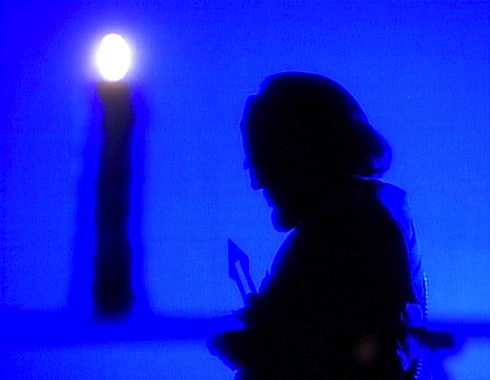Once again, I apologize for delaying the Thursday rewatch to Friday. Feel free to throw your tomatoes at leisure.
“The Bonding”
Written by Ronald D. Moore
Directed by Winrich Kolbe
Season 3, Episode 5
Production episode 40273-153
Original air date: October 23, 1989
Stardate: 43198.7
Captain’s Log: Worf is leading an away team to investigate the ruins on an uninhabited world that was home to the Koinonians, a now-extinct species that destroyed themselves in a generations-long war. There is an explosion on the surface, and Worf calls for emergency beam-up. One of the team, an archaeologist named Marla Aster, is dead on arrival, having borne the brunt of the explosion. Scans had indicated no weapons or traps.
Aster had family on board: her son, Jeremy. Her husband, Jeremy’s father, died five years previous, so the boy is orphaned.
La Forge takes an away team to the dig site to find a whole mess of mines like the one that killed Aster, all of which have inexplicably been unearthed and defused. They’re left over from the Koinonians’ lengthy war.
Worf wishes to make R’uustai with Jeremy, a Klingon bonding ceremony. Troi advises him to take it slow, and Worf instead visits with Jeremy to talk with him about his mother.
They pick up an energy signature on the planet, one which Troi senses as a presence, and which also is messing with the magnetic containment unit in engineering. As that happens, Aster appears to Jeremy—not in uniform, but in the civilian clothes she is wearing in the home videos Jeremy’s watching. She says that there was “a mistake,” and that she’s fine—and that they’ll be living on the planet below from now on. Worf arrives and is rather shocked to see Aster alive. She tries to bring him down to the planet, but Picard refuses to allow it.
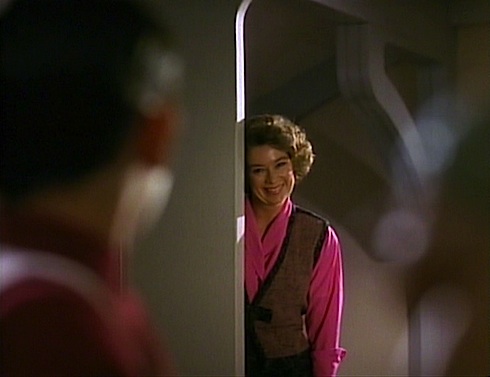
Troi takes Jeremy back to his quarters—only to find that they’ve been transformed into their old house back on Earth. The counselor confronts the false Aster, asking why she would create this fantasy; her response is that it’s what Jeremy wants, and that it is real. Even his old cat, Patches, is there.
La Forge and Data figure out a way to cut off the energy that is powering the manifestation of Aster and the re-creation of their house, but it proves to be only temporary, as the energy attacks the Enterprise, kicking O’Brien out of the transporter room, taking down two security guards, and once again manifesting both Aster and the house in the Aster quarters. Picard traps them on that deck with force fields, and goes there to confront the fake Aster.
She finally explains herself: Two species lived on the world, one of matter (the Koinonians) and one of energy (who created Aster). They re-created Marla Aster to make up for what happened. She insists that she can give Jeremy happiness and a lack of suffering—Troi asks what he’ll do for friends, an education, a career, a life, with Picard reinforcing the point that humans are mortal and must deal with death, not hide from it in memories and fantasy.
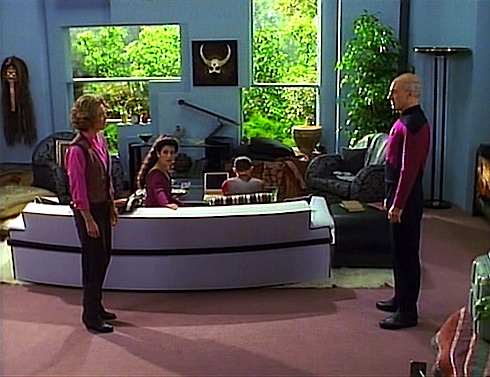
On Picard’s order, Worf brings Wes to the Aster quarters. Wes talks about the day Picard told him and Crusher about his father’s death, and how angry he was at Picard. Troi then points out that Jeremy should be angry at Worf—sure enough, the kid lashes out at Worf, asking why he came back and she didn’t.
While he can’t answer that, Worf does tell Jeremy that he, too, is an orphan. He also says that the Marla Aster he knew is not present in the cabin nor on the planet—she exists in his heart and Jeremy’s. He then proposes the R’uustai—a bonding that will make them brothers.
Seeing this, the energy being realizes that Jeremy won’t be alone and that he needs to grieve and move on, not live in the past. She disappears without a word, only a last comforting gesture to Jeremy.
In Worf’s quarters, they perform the bonding ritual, which includes a lot of lighting of candles….
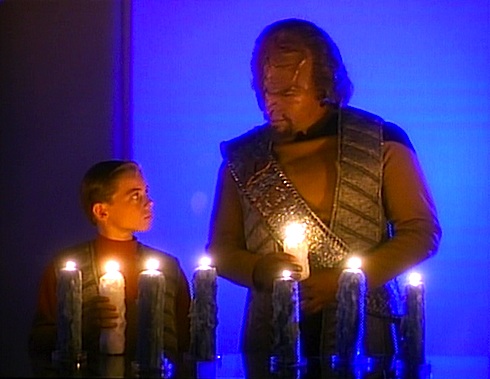
Can’t We Just Reverse the Polarity?: The mine that killed Aster has a subspace proximity detector, which renders it invisible to tricorders.
Thank You, Counselor Obvious: This is one of Troi’s better episodes, as she provides valuable guidance to Picard, Worf, Jeremy, and Wes. While en route to give Jeremy the bad news about his mother, Picard expresses his discomfort with having children on board the ship, and Troi rightly points out that not being on board wouldn’t have protected him, as he’d still have lost his mother. She also tries to get Worf to talk about what he’s dealing with, and sorta kinda succeeds.
I also particularly like Troi’s inability to focus entirely on the energy being on the surface because the emotions of the crew are too strong for her to filter them out.
The Boy!?: The events of the episode hit hard for Wes, as this reminds him a lot of what he went through when his own father died—he and his mother have a particularly powerful scene when they find themselves remembering Jack Crusher. He also gets a bit of catharsis when he finally tells Picard how angry he was at the captain years ago for ordering his father to his death.
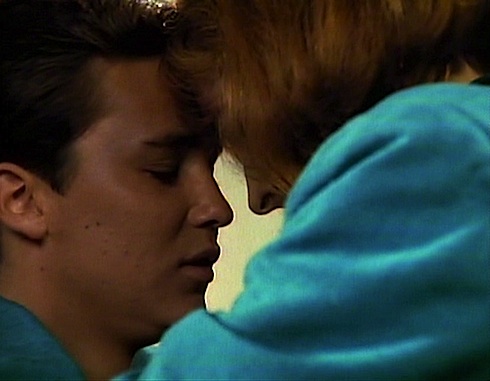
There is No Honor in Being Pummeled: Worf finally gets to lead an away team, and loses a person under his command. He struggles to deal with it, especially since, as he puts it, “I cannot take revenge against an enemy turned to dust centuries ago.” He eventually does undergo the R’uustai with Jeremy—”We have bonded and our families are stronger.”
If I Only Had a Brain…: Data tries to understand why people keep asking how well people knew Aster, as well as why grief is more keenly felt when it is a friend, specifically referencing the death of Tasha Yar.
No Sex, Please, We’re Starfleet: When Data asks Riker how well he knew Aster, he smiles and says, “We spent some time together,” which you just know is a euphemism. Wah-hey!
Welcome Aboard: Susan Powell is fantastic as Marla Aster, with subtle expressions, strong emotions, and an understated attitude. Sadly, Gabriel Damon is simply awful as Jeremy: wooden, unconvincing, robotic.
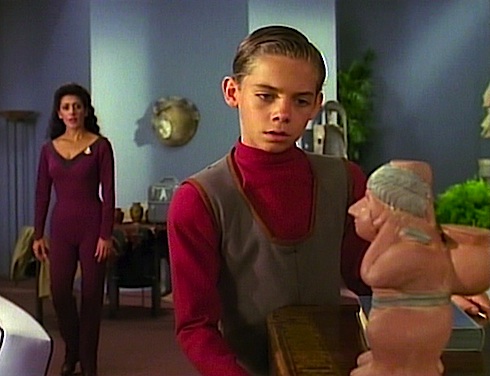
I Believe I Said That: “A leader must stand alone—as Captain Picard does.”
“Captain Picard talks to me!”
Worf trying to be stoic and Troi whupping him upside the head.
Trivial matters: This was a spec script that Ronald D. Moore submitted, and which Michael Piller—coming in late as showrunner with very few scripts—found on the slush pile. It led to Moore being made a part of the writing staff for TNG and later Deep Space Nine, eventually becoming co-executive producer of the latter show. He worked briefly on Voyager, as well, making him one of the few to work on staff for all three 24th-century series. He later went on to work on many shows, most notably as the showrunner for the acclaimed SyFy reboot of Battlestar Galactica.
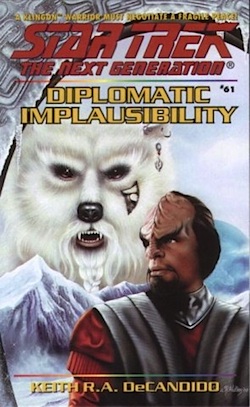
Despite being made part of Worf’s family, Jeremy was never seen or mentioned again on screen (though his mother’s death would be referenced again in “Ethics” by Riker to Worf). He did appear in a 1991 issue of DC’s Star Trek: The Next Generation comic book by Michael Jan Friedman, Peter Krause, & Pablo Marcos, as well as the TNG novels Genesis Force by John Vornholt and Diplomatic Implausibility by your humble rewatcher.
Make it So: “Her death was senseless—the last victim of a forgotten war!” Quite simply one of TNG‘s finest. Written by the best writer of modern Trek — Moore would go on to write a lot of great episodes of TNG and DS9 (not to mention co-writing two movies), all the way through to his final script for the franchise, the Voyager episode “Survival Instinct”—and the best director in Kolbe, we get a simply excellent episode.
The plot itself is fairly standard, but what makes it stand out is the spectacular character work by Moore (with some uncredited script doctoring by Michael Piller and Melinda M. Snodgrass) and the excellent visuals by Kolbe. So many brilliant scenes: Wes’s discomfort as he’s reminded of his father and just pours out his grief, first to his mother and then later to Picard; Data and Riker’s talk in Ten-Forward, filmed in intimate closeup; Picard and Troi’s solemn talk in the turbolift about children on the ship; Worf and Troi’s somewhat more contentious talk in the computer room, filmed superbly through the grating; Picard drawing out Wes’s anger; Worf’s frank talk to Jeremy, culminating in his offer to make R’uustai.
The best scene of all, though, is all Kolbe: Worf silhouetted in the background of his darkened quarters, lit only by a candle in the foreground, Worf slowly walking up to the candle holding a d’k tahg, and solemnly putting the candle out with the flat of the blade. Simply a beautiful, understated, powerful scene in an episode filled with them.
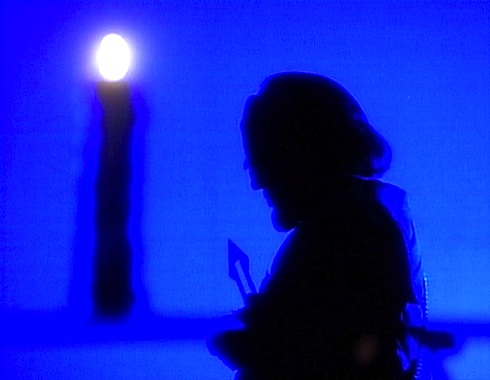
Every character moment in this episode is simply right, with not a single misstep, building beautifully on what we know of them—Data’s relationship with Yar, the death of Jack Crusher, Worf’s being orphaned, Picard’s discomfort with families on the ship, and so on. The actors rise to the occasion, too, as everyone is simply excellent—from Sir Patrick Stewart’s strong leadership all the way down to Colm Meaney, whose facial expression when the false Marla Aster enters the transporter room is just priceless.
In particular what I love about this episode is that it deals with the realities of death, and moves past the tiresome Trek cliché of the expendable redshirt. So often we’ve seen guest characters die without any thought given to who they are or even noticing or caring about them by the time the hour is over. It’s such a relief to see an episode where a member of the away team dies and it matters. After all, this is supposed to be a community of people alone in a tin can for months on end, it should really mean something when someone dies regardless of whether or not their character is listed in the opening credits.
The only flaw in the episode is the rather unfortunate casting of Gabriel Damon—who would go on to be equally wooden and stiff in RoboCop 2—as Jeremy, which takes some wind out of the story’s sails.
Still, it’s great stuff, from modern Trek‘s best.
Warp factor rating: 9
Keith R.A. DeCandido‘s first-ever Star Trek novel was Diplomatic Implausibility way back in 2001, a story which featured a cameo by Jeremy Aster ten years after this episode took place. You can get autographed copies of several of his novels and comic books directly from him. Autographed copies of the print editions of his fantastical police procedurals SCPD: The Case of the Claw and Dragon Precinct (the latter a trade reissue of the 2004 novel) are also available for preorder. Find out more about Keith at his web site, which is a portal to (among many other things) his Facebook page, his Twitter feed, his blog, and his podcasts, Dead Kitchen Radio, The Chronic Rift, and the Parsec Award-winning HG World.










